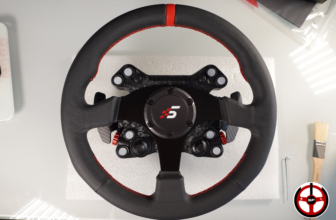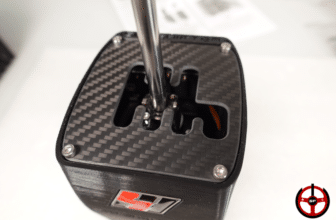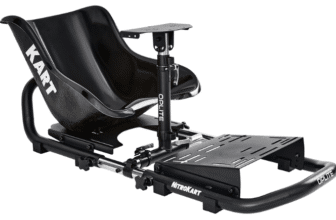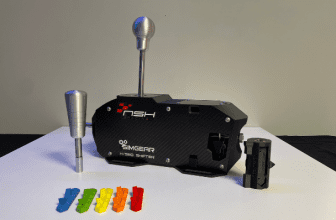Sim Racing equipment, like all mechanical parts, requires a little care from time to time. And depending on the type of equipment you choose, maintenance can range from a simple dusting to half a day’s hard work. Today, I’d like to take stock of the situation. Let’s take a look at what you need to do to maintain your Load Cell simracing pedalset.
Because, while this type of pedalset requires relatively little maintenance, you shouldn’t leave them completely freewheeling either. At least if you want to maximize the life of your pedalset’s wearing parts. You’ve probably noticed that pedalset manufacturers often sell wear parts at a premium… So let’s take a look at where you can find low-cost (elastomer) rubber!
How do Load Cell pedalsets work?
Here’s a quick recap, for those who aren’t yet too familiar with Load Cell pedalsets. The term Load Cell refers to the way in which the pedalboard captures the information sent by your foot. In a nutshell, there are 3 main types of pick-up modes at the moment. Potentiometers, Load Cells and hydraulic pressure sensors (actually very rare because they’re very expensive).
Want to find out more? –-> the SimRacing pedalset guide
But let’s get back to what we’re interested in here: the Load Cell. When you step on the brake pedal, your foot will apply weight to the pedal. This weight will be applied to the sensor, which will be able to transform this information into a braking percentage in the game. And if these sensors are becoming the norm in pedal units, it’s because they enable far more effective and realistic braking control than potentiometers, which only take pedal movement into account.
So much for the capture part. But there’s also the “movement” part ! Because to make your pedal move and return to its original position, you need to put something behind it. You can choose between springs,elastomers, hydraulic cylinders or pneumatic shock absorbers.
What are the wearing parts on a Load Cell pedalset?
Well, now that we’ve covered the basics, we can move on to what interests us most today. Load Cell pedalset maintenance. So the first thing to look out for are wear parts. Those which, despite all your love for your equipment, will eventually need changing.

These are the elastomers. Elastomers are rubber compounds of varying degrees of hardness, depending on the model you choose. They give you feedback when you press down on the pedal, and allow the pedal to return to its original position when you release it.
They have quite a few advantages! In particular, they replicate the feel of a real race car pedalbox and require very little maintenance. But you should be aware that, depending on your use, you’ll probably need to change your elastomers every 2 to 3 years. Over time, they’ll become soft and crack.
So don’t panic! Changing these elastomers is child’s play, and in any case, we’ll see how to maximize their lifespan 😉
By maintaining and lubricating your elastomers you will really save them hundreds of hours of use life. This will also allow you to maintain the original hardness of the rubber and therefore the feeling of your brake pedal for as long as possible. It would be a shame to start with an F1 brake and end up with that of a Clio 1, wouldn’t it?
ps: you’ll notice that I go from masculine to feminine depending on whether I’m talking about elastomers or rubber. It’s a bit laborious, but I can’t help it: it’s an elastomer and a rubber..
Basic maintenance equipment for my pedalset
Let’s get our hands dirty, starting of course with the preparation of the equipment needed for our pedalset maintenance. The list I’m proposing is the one that seems ideal to me, but of course you don’t have to follow it. What counts is that the maintenance is done, no matter if you use a broom rather than a vacuum cleaner..
- The tools (if necessary) generally provided by the pedalset manufacturer to remove the brake pedal axle.
- 1 vacuum cleaner / brush / dusting wipe, in short something to remove the layer of dust and deposits that have formed on the pedal board.
- 1 tube of silicone grease. Prefer grease in a tube or pot rather than in a spray to avoid dripping.
- 1 can of dry air. It’s optional, but still very practical for dislodging dust in the hidden corners of the pedal board.
- 1 dry cloth that does not lose fibers (!!) to clean the erasers if necessary.
Maintenance of a Load Cell elastomer pedalset
Having gathered the opinions of 3 different pedalset manufacturers and from what I’ve seen over time on my own pedalsets, here’s what I recommend:

- Every 50 to 70 hours of play or 4 to 6 months, vacuum the pedalboard thoroughly and remove all the dust and dirt that has settled on it. Particularly clean the joints of the pedalset. If you are going to grease them they must be really clean!
- Remove the elastomers from your brake pedal and check their condition. They should not be dry (still a little greasy) and not be cracked.
- If the elastomers are dirty, clean them with a dry cloth. Clean the axle on which the elastomers are fitted if it is dusty.
- With Silicone Grease, grease the axle on which the elastomers are fitted or the rubber itself if it does not have an axle passing through it (like on the Fanatec Clubsport V3 for example).
- A little lubrication on all the joints of the pedalset to avoid squeaks and unnecessary wear of moving parts.
- If you have potentiometers on your accelerator and clutch pedals, a quick blast of dry air to dust them never hurts. You will notice that these knobs are real dust magnets and in the long run this can interfere with the signal they send…
- Carefully reassemble your pedalset and make sure everything is working properly before storing the tools.
And that’s it! You’ve serviced your pedalset and its rubber. As you can see, it only took you about 15 minutes at the most, and now you can look at your pedalset as good as new with the satisfaction of a job well done. Good job!
A few everyday recommendations
As far as the joints are concerned, if they squeak, you need to grease them. Don’t wait 50 hours to grease a noisy mechanism. In general, a greased joint won’t hurt your ears for at least 1 year 😉
Avoid placing your pedalset where the sun ‘s rays will hit the elastomers directly. The sun will dry them out and they’ll crack much faster. Depending on the layout of the room you’re in, this isn’t always easy. But do what you can to protect them from direct sunlight.
Finally, I strongly advise you to respect the weights recommended by the manufacturers for each elastomer hardness. For example, if you apply a daily weight of 90Kg to your brake rubber, even though it is designed for a 60Kg setting, it will be over-compressed every time and will crack much faster than expected.
Not all pedalsets are equal when it comes to maintenance
Over the course of my tests and as the market has evolved, I’ve noticed that not all pedalsets are equal in terms of the maintenance they require. For example, pedalsets where the elastomers are “hidden” in a cylinder require much less maintenance than pedalsets where they are open to the air. To give you a concrete example, an Asetek Forte will require greasing every 100 to 120 hours of use, whereas a Venym Atrax will require greasing every 50 to 70 hours of use.
Rubber life is also affected by cylinders for a whole host of reasons. Starting with the fact that they are not exposed to dust and sunlight. But also, in some cases, because they are not used in the same way!
To take a concrete example from the Asetek Forte, the elastomer is in a cylinder and the pedal travel is limited by a ring that stops the movement. In this case, it’s impossible to over-compress the rubber, which preserves its lifespan.
The pedalsets cited here as examples are just for context. The same rules apply to pedalsets of other brands using the same type of technology.
My pedalset maintenance shopping list
If you’re not sure what maintenance equipment to choose, here’s my personal shopping list. Of course you can choose other brands, but I’m only giving you my choices as a guide.
For grease, I use a tube of “CAMP silicone grease” which you can easily find on Amazon. I chose this model because the price per weight seemed attractive. Nothing to say about its use, it does the job perfectly, nothing more, nothing less. Count 12€ for a tube that will certainly suffice for your entire simracer life. Unless, like me, you’ve developed a passion for greasing and start frantically greasing every moving part in your home!
As far as the dry air bottle is concerned, any model you buy in a computer store or online will do the trick. Expect to pay less than €5 for a few years’ respite.
Where can I find replacement elastomers?
Beyond maintenance, it’s also important to know where to find replacement elastomers. Because sooner or later, the ones you’ve got on your pedalset will fail – that’s nature’s way. But you may also want to find elastomers with different hardnesses to modulate the feel of your brake!
And what we’ve all noticed is that pedalset manufacturers tend to sell elastomer kits at quite high prices… I’ve often been asked why rubber kits are so expensive, and the reason is quite simply economic. It’s on small accessories that brands can hope to make really interesting margins. To give you an example, it’s exactly like musical instrument stores, which live mainly off the sale of accessories, while the instruments earn them “almost nothing” (note the quotation marks).
Even if I’m the first to respect the fact that a company has to make a living and therefore make money in order to offer us quality products… I have to admit that sometimes, the prices of elastomer kits are a little “abused”. Especially since almost all brands buy from the same suppliers. You can find rubber sold in sets for a tenth of the price!
Fibroflex elastomers
Fibroflex supplies most high-end pedalset manufacturers. Among its customers are a string of copies of Heusinkveld, Venym, Asetek and many others. They’re far from being the cheapest rubber available, but their quality is undeniable and they really do last over time. You can buy them individually or in kits from simraceshop.de or BRWtoolshop. Convenient, but still quite expensive on these sites.
Paul elastomers
Ahhh, our very own rubber! On the Solutions Elastomères site, you’ll find much cheaper erasers sold in sets. I recently placed an order with them and in a few weeks’ time I’ll give you a review of what I think of their models. Because at this price, even if their rubber is a little less durable over time, it’s clearly worth it!
Do you have any other addresses?
Here you are! You now know everything about the maintenance of Load Cell pedalsets fitted with elastomers. I hope you enjoy looking after your pedals. You’ll be amazed at how this simple, occasional maintenance can extend the life of the rubber.
By the way, if you know of any other places where you can find cheaper elastomers, please let me know in the comments! I’d be delighted to try out your good addresses and add them to the article 😉
See you soon just below!






